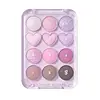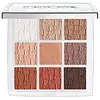What's inside
What's inside
 Key Ingredients
Key Ingredients

 Benefits
Benefits

 Concerns
Concerns

 Ingredients Side-by-side
Ingredients Side-by-side

Calcium Titanium Borosilicate
AbrasiveTalc
AbrasiveDiisostearyl Malate
EmollientCaprylic/Capric Triglyceride
MaskingTitanium Dioxide
Cosmetic ColorantHydrogenated Castor Oil Isostearate
Skin ConditioningZinc Stearate
Cosmetic ColorantCalcium Sodium Borosilicate
Calcium Aluminum Borosilicate
Silica
AbrasiveMica
Cosmetic ColorantCaprylyl Glycol
EmollientTin Oxide
AbrasiveGlyceryl Caprylate
EmollientEthylhexylglycerin
Skin ConditioningCI 77491
Cosmetic ColorantStearic Acid
CleansingWater
Skin ConditioningCI 75470
Cosmetic ColorantTocopherol
AntioxidantSynthetic Fluorphlogopite
CI 77510
Cosmetic ColorantPolymethyl Methacrylate
Lauroyl Lysine
Skin ConditioningDimethicone
EmollientOctyldodecyl Stearoyl Stearate
EmollientIsocetyl Myristate
EmollientMagnesium Myristate
Aluminum Hydroxide
EmollientTriethoxycaprylylsilane
Hydrogenated Lecithin
EmulsifyingCI 77492
Cosmetic ColorantUltramarines
Kaolin
AbrasiveCI 77742
Cosmetic ColorantCI 77499
Cosmetic ColorantCalcium Titanium Borosilicate, Talc, Diisostearyl Malate, Caprylic/Capric Triglyceride, Titanium Dioxide, Hydrogenated Castor Oil Isostearate, Zinc Stearate, Calcium Sodium Borosilicate, Calcium Aluminum Borosilicate, Silica, Mica, Caprylyl Glycol, Tin Oxide, Glyceryl Caprylate, Ethylhexylglycerin, CI 77491, Stearic Acid, Water, CI 75470, Tocopherol, Synthetic Fluorphlogopite, CI 77510, Polymethyl Methacrylate, Lauroyl Lysine, Dimethicone, Octyldodecyl Stearoyl Stearate, Isocetyl Myristate, Magnesium Myristate, Aluminum Hydroxide, Triethoxycaprylylsilane, Hydrogenated Lecithin, CI 77492, Ultramarines, Kaolin, CI 77742, CI 77499
Synthetic Fluorphlogopite
Calcium Aluminum Borosilicate
Mica
Cosmetic ColorantOctyldodecyl Stearoyl Stearate
EmollientZea Mays Starch
AbsorbentZinc Stearate
Cosmetic ColorantSilica
AbrasiveRosa Canina Fruit Oil
EmollientCaprylyl Glycol
EmollientPentylene Glycol
Skin ConditioningCentaurea Cyanus Flower Water
Skin ConditioningSodium Dehydroacetate
PreservativeLauroyl Lysine
Skin ConditioningBis-Behenyl/Isostearyl/Phytosteryl Dimer Dilinoleyl Dimer Dilinoleate
EmollientTin Oxide
AbrasivePinus Pentaphylla Seed Oil
EmollientStearic Acid
CleansingWater
Skin ConditioningSodium Benzoate
MaskingPotassium Sorbate
PreservativeCI 77891
Cosmetic ColorantCI 77491
Cosmetic ColorantCI 77499
Cosmetic ColorantCI 77000
Cosmetic ColorantCalcium Sodium Borosilicate
Isostearyl Neopentanoate
EmollientSodium Glycerophosphate
CI 77492
Cosmetic ColorantDimethicone
EmollientDiisostearyl Malate
EmollientTrihydroxystearin
Skin ConditioningDimethicone/Vinyl Dimethicone Crosspolymer
Skin ConditioningTrimethylolpropane Triethylhexanoate
EmollientDimer Dilinoleyl Dimer Dilinoleate
EmollientMagnesium Myristate
Magnesium Stearate
Cosmetic ColorantEthylhexylglycerin
Skin ConditioningSorbitan Sesquiisostearate
EmulsifyingGlyceryl Caprylate
EmollientTocopherol
AntioxidantSynthetic Fluorphlogopite, Calcium Aluminum Borosilicate, Mica, Octyldodecyl Stearoyl Stearate, Zea Mays Starch, Zinc Stearate, Silica, Rosa Canina Fruit Oil, Caprylyl Glycol, Pentylene Glycol, Centaurea Cyanus Flower Water, Sodium Dehydroacetate, Lauroyl Lysine, Bis-Behenyl/Isostearyl/Phytosteryl Dimer Dilinoleyl Dimer Dilinoleate, Tin Oxide, Pinus Pentaphylla Seed Oil, Stearic Acid, Water, Sodium Benzoate, Potassium Sorbate, CI 77891, CI 77491, CI 77499, CI 77000, Calcium Sodium Borosilicate, Isostearyl Neopentanoate, Sodium Glycerophosphate, CI 77492, Dimethicone, Diisostearyl Malate, Trihydroxystearin, Dimethicone/Vinyl Dimethicone Crosspolymer, Trimethylolpropane Triethylhexanoate, Dimer Dilinoleyl Dimer Dilinoleate, Magnesium Myristate, Magnesium Stearate, Ethylhexylglycerin, Sorbitan Sesquiisostearate, Glyceryl Caprylate, Tocopherol
 Reviews
Reviews

Ingredients Explained
These ingredients are found in both products.
Ingredients higher up in an ingredient list are typically present in a larger amount.
Calcium Aluminum Borosilicate is made up of calcium, aluminum, and silicates. It is a glass-like material. In cosmetics, it comes in the form of flakes or microspheres.
Calcium aluminum borosilicate is a bulking agent, meaning it helps thicken a product.
This ingredient is created by slowly mixing several minerals, including kaolin clay.
Although “aluminum” in an ingredient name can raise red flags for some consumers, the form and usage context matter significantly. For typical topical applications, there is no substantial evidence of health risks - such as cancer, neurotoxicity, or systemic “aluminum overload.”
Learn more about Calcium Aluminum BorosilicateCalcium Sodium Borosilicate is a bulking agent. It is considered a borosilicate glass; it is composed of powder or flakes of calcium and sodium borosilicates.
This ingredient is used to add volume, shine, and color to products. You'll most likely find this ingredient in makeup products.
According to in-vivo and ex-vivo studies done by a manufacturer, this ingredient works well with UV filters:
Learn more about Calcium Sodium BorosilicateCaprylyl Glycol is a humectant and emollient, meaning it attracts and preserves moisture.
It is a common ingredient in many products, especially those designed to hydrate skin. The primary benefits are retaining moisture, skin softening, and promoting a healthy skin barrier.
Though Caprylyl Glycol is an alcohol derived from fatty acids, it is not the kind that can dry out skin.
This ingredient is also used as a preservative to extend the life of products. It has slight antimicrobial properties.
Learn more about Caprylyl GlycolCi 77491 is also hydrated iron III oxide. It's sole purpose is to give a red/pink hue to products.
Iron III oxides are classified as inorganic chemicals for coloring.
Synthetically created Ci 77491 is considered safer than those naturally found. This is because the synthetically created version may contain less impurities. Iron oxides are generally non-toxic and non-allergenic.
Learn more about CI 77491Ci 77492 is also hydrated iron III oxide. It's sole purpose is to give a yellow hue to products.
Iron III oxides are classified as inorganic chemicals for coloring.
Synthetically created Ci 77492 is considered safer than those naturally found. This is because the synthetically created version may contain less impurities. Iron oxides are generally non-toxic and non-allergenic.
Learn more about CI 77492Ci 77499 is also hydrated iron III oxide. It is created from mixing red and black iron oxides. This helps give shades of darkness to a product.
Iron III oxides are classified as inorganic chemicals for coloring.
Diisostearyl Malate is an emollient and most often used in lip products. It comes from isostearyl alcohol, a fatty acid, and malic acid, an AHA.
As an emollient, Diisostearyl Malate helps create a thin film on your skin to trap moisture in. This helps keep your skin soft and smooth.
Dimethicone is a type of synthetic silicone created from natural materials such as quartz.
What it does:
Dimethicone comes in different viscosities:
Depending on the viscosity, dimethicone has different properties.
Ingredients lists don't always show which type is used, so we recommend reaching out to the brand if you have questions about the viscosity.
This ingredient is unlikely to cause irritation because it does not get absorbed into skin. However, people with silicone allergies should be careful about using this ingredient.
Note: Dimethicone may contribute to pilling. This is because it is not oil or water soluble, so pilling may occur when layered with products. When mixed with heavy oils in a formula, the outcome is also quite greasy.
Learn more about DimethiconeEthylhexylglycerin (we can't pronounce this either) is commonly used as a preservative and skin softener. It is derived from glyceryl.
You might see Ethylhexylglycerin often paired with other preservatives such as phenoxyethanol. Ethylhexylglycerin has been found to increase the effectiveness of these other preservatives.
Glyceryl Caprylate comes from glycerin and caprylic acid, a fatty acid from coconut. It has emollient and emulsifier properties.
As an emollient, it helps hydrate your skin. Emollients work by creating a barrier on your skin to trap moisture in, helping to keep your skin soft and smooth.
On the other hand, emulsifiers prevent ingredients (such as oil and water) from separating.
Learn more about Glyceryl CaprylateThis ingredient comes from a fatty acid (lauric acid) and amino acid (lysine). It is used to add a silky feel to cosmetics.
According to a manufacturer, its fatty acid base leaves a silky feeling on the skin. It also has emollient properties because of this. Emollients help soften skin by preventing water from evaporating.
Lauroyl lysine is barely soluble in water.
Learn more about Lauroyl LysineWe don't have a description for Magnesium Myristate yet.
Mica is a naturally occurring mineral used to add shimmer and color in cosmetics. It can also help improve the texture of a product or give it an opaque, white/silver color.
Serecite is the name for very fine but ragged grains of mica.
This ingredient is often coated with metal oxides like titanium dioxide. Trace amounts of heavy metals may be found in mica, but these metals are not harmful in our personal products.
Mica has been used since prehistoric times throughout the world. Ancient Egyptian, Indian, Greek, Roman, Aztec, and Chinese civilizations have used mica.
Learn more about MicaOctyldodecyl Stearoyl Stearate is created from stearic acid.
It is an emollient and thickens the lipid (oil) portion of a product. Due to its emollient properties, it may not be fungal-acne safe.
Silica, also known as silicon dioxide, is a naturally occurring mineral. It is used as a fine, spherical, and porous powder in cosmetics.
Though it has exfoliant properties, the function of silica varies depending on the product.
The unique structure of silica enhances the spreadability and adds smoothness, making it a great texture enhancer.
It is also used as an active carrier, emulsifier, and mattifier due to its ability to absorb excess oil.
In some products, tiny microneedles called spicules are made from silica or hydrolyzed sponge. When you rub them in, they lightly polish away dead skin layers and enhance the penetration of active ingredients.
Learn more about SilicaStearic Acid is a fatty acid. It is an emollient, emulsifier, and texture enhancer.
As an emollient, stearic acid helps soften skin. It aids the skin's protective barrier by preventing water loss. It also provides a gentle cleansing effect without stripping away natural oils.
Stearic acid may also be used to enhance the texture of products. It can add volume and stabilize ingredients such as water and oil. This can help water and oil ingredients from separating.
Sources of stearic acid include animal or vegetable fats/oils such as coconut or shea. It can be naturally found in butter, cocoa butter, shea butter, vegetable fats, and animal tallow.
This ingredient may not be Malassezia folliculitis, or fungal-acne safe.
Learn more about Stearic AcidSynthetic Fluorphlogopite is the synthethic version of mica. It consists of fluorine, aluminum and silicate.
Synthetic Fluorphlogopite is used to add volume to products.
It is considered non-irritating on the skin.
Learn more about Synthetic FluorphlogopiteTin Oxide is an inorganic oxide used to add opacity and volume to a product. In nature, it is already found in mineral form. The main ore of tin is an opaque and shiny mineral called casseterite.
Tin Oxide helps remove translucency in a product, or make it more opaque. Besides adding opacity, tin oxide is used for bulking to add volume.
Tocopherol (also known as Vitamin E) is a common antioxidant used to help protect the skin from free-radicals and strengthen the skin barrier. It's also fat soluble - this means our skin is great at absorbing it.
Vitamin E also helps keep your natural skin lipids healthy. Your lipid skin barrier naturally consists of lipids, ceramides, and fatty acids. Vitamin E offers extra protection for your skin’s lipid barrier, keeping your skin healthy and nourished.
Another benefit is a bit of UV protection. Vitamin E helps reduce the damage caused by UVB rays. (It should not replace your sunscreen). Combining it with Vitamin C can decrease sunburned cells and hyperpigmentation after UV exposure.
You might have noticed Vitamin E + C often paired together. This is because it is great at stabilizing Vitamin C. Using the two together helps increase the effectiveness of both ingredients.
There are often claims that Vitamin E can reduce/prevent scarring, but these claims haven't been confirmed by scientific research.
Learn more about TocopherolWater. It's the most common cosmetic ingredient of all. You'll usually see it at the top of ingredient lists, meaning that it makes up the largest part of the product.
So why is it so popular? Water most often acts as a solvent - this means that it helps dissolve other ingredients into the formulation.
You'll also recognize water as that liquid we all need to stay alive. If you see this, drink a glass of water. Stay hydrated!
Learn more about WaterZinc Stearate is the metal salt of stearic acid. It is a white solid used to bind, thicken, and lubricate products.
This ingredient is common in powder makeup, where it helps keep the powder together.
Zinc Stearate is hydrophobic and repels water.
This ingredient can be sourced from non-animal or animal sources. It is best to reach out to the brand to see where they source this ingredient from.
Learn more about Zinc Stearate